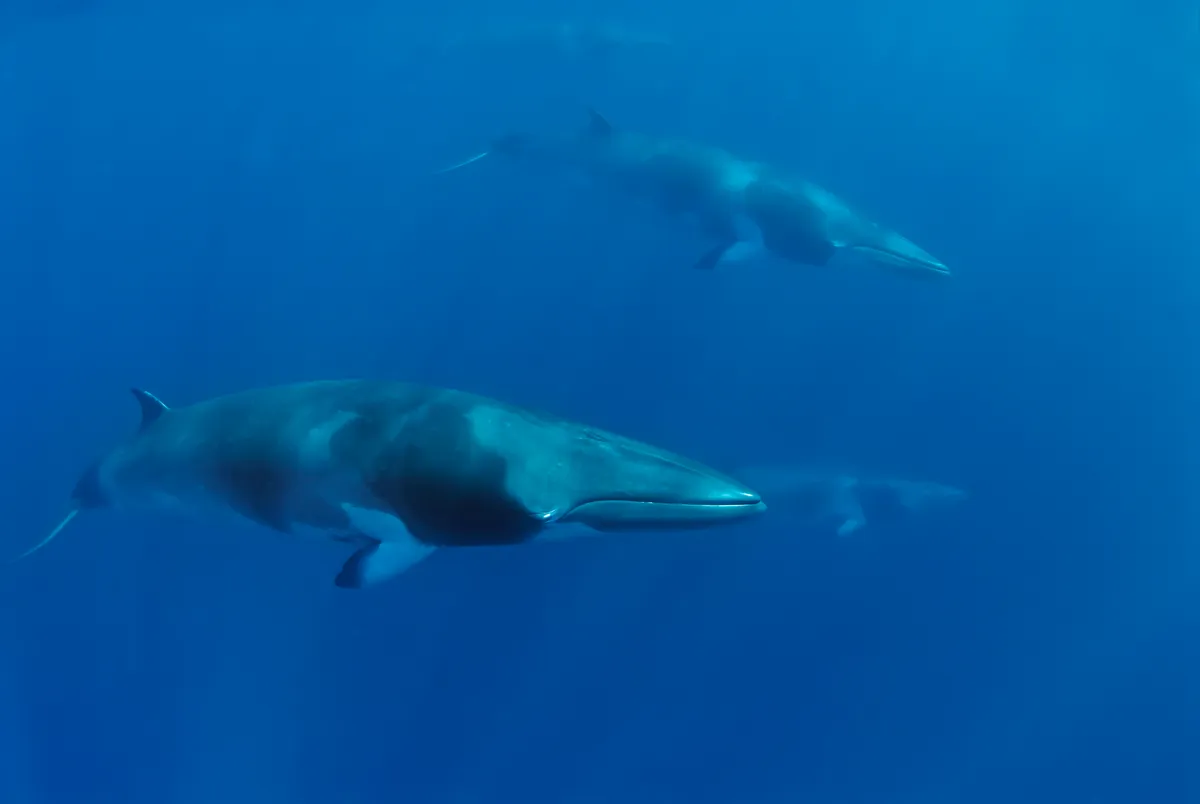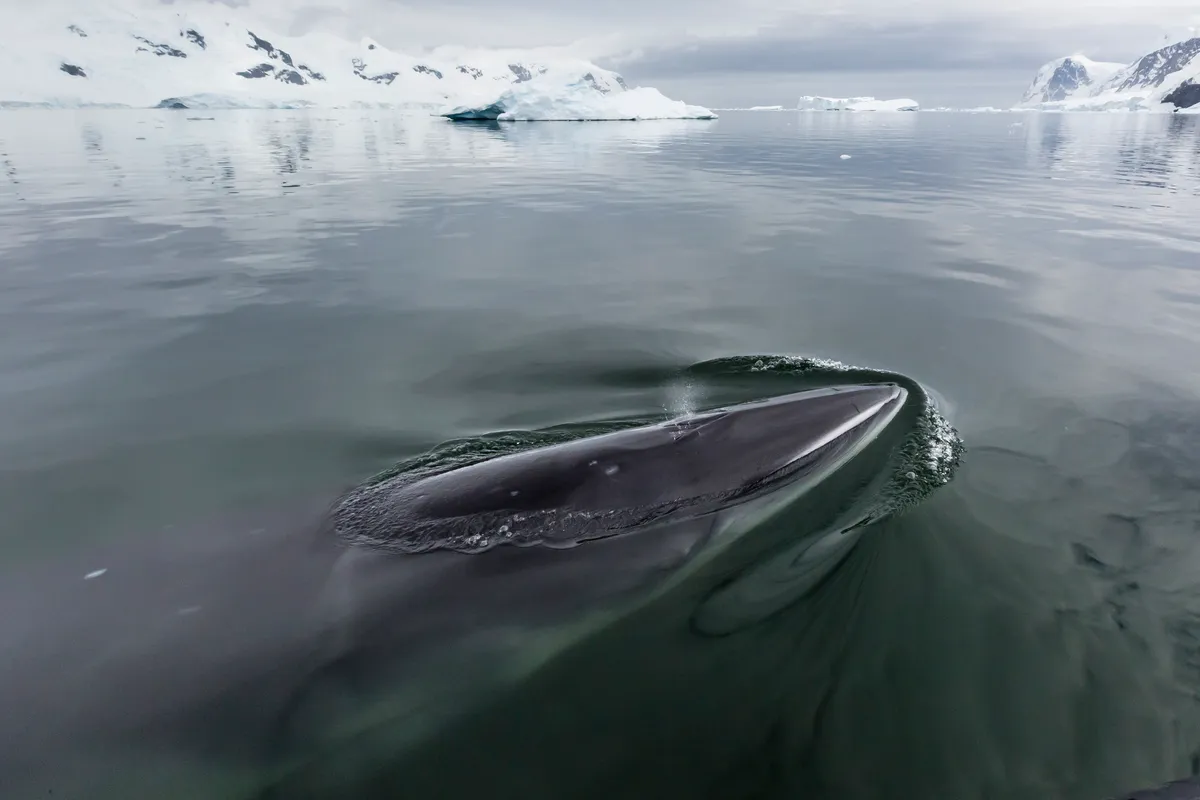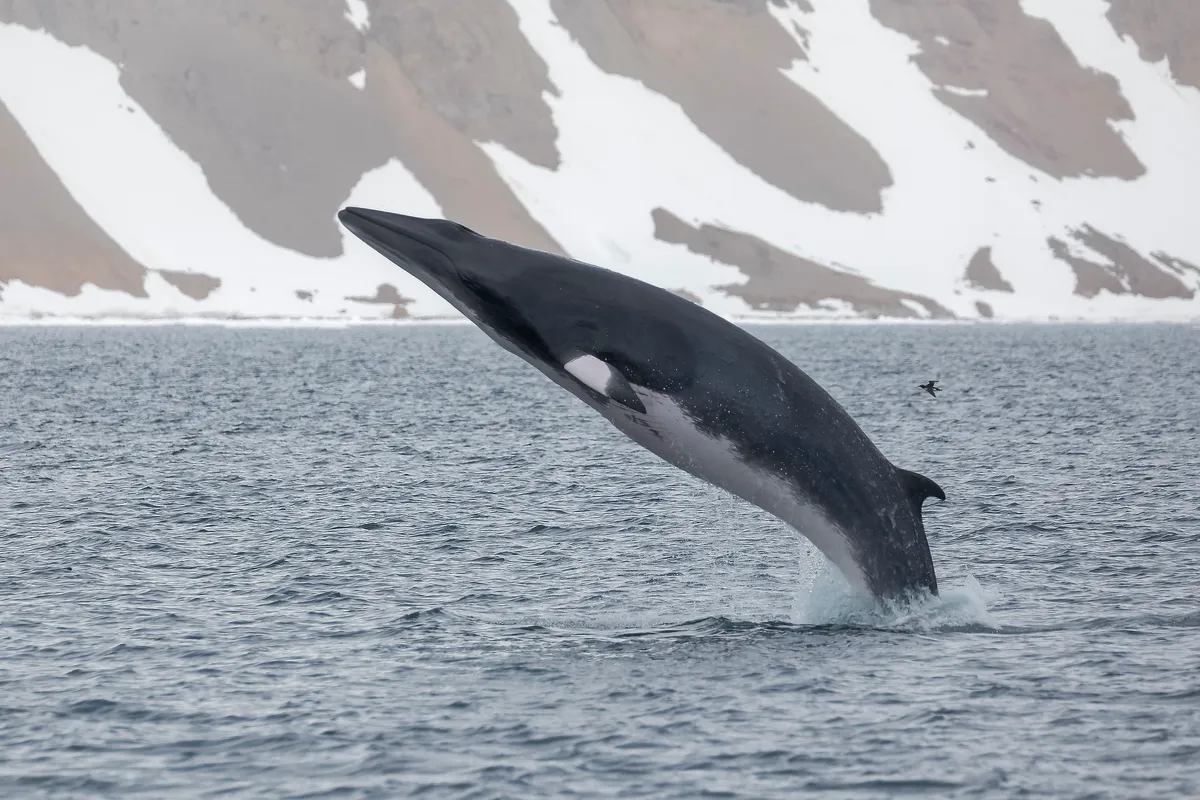What are minke whales?
Minke whales are one of 16 species belonging to the family of Baleen whales
How big are minke whales?
Minkes are the smallest of the whales, with males growing 8 metres and females reaching 8.5 metres.
What do minke whales look like?
Minke whales are dark grey to black on the back and lighter on the undersides, with some individuals having a white band on the front flippers. Calves are usually darker than adults.
The whales have a small dorsal fin, which accumulates scars throughout its life. In the same way that scientists use the unique flukes of humpbacks to create a profile of different individuals, the dorsal fin of the minke can be used to tell whales apart. The Hebridean Whale and Dolphin Trust uses the profiles to track behaviour of the whales in the Hebrides.
More research is being done on different populations of Minke whales, which vary in size, colour and baleen distribution. Northern minke whales are the type displaying the white band in the middle of the flipper, and they have white baleen plates.
Dwarf minkes are a significantly smaller subspecies of the northern minke, though they live in the southern hemisphere. They have a black border around their baleen plates, and a bright white patch on the upper part of the flipper near the shoulder.
Antarctic minke whales in general have less baleen plates than the northern minke, and they have asymmetrical colour patterning on it, with fewer white patches on the left side than on the right side of the mouth.
Where do minke whales live?
Northern hemisphere Minke whales are comfortable in both tropical waters and polar waters. While their migratory patterns are not as well understood as humpbacks, it is thought they follow a similar pattern, visiting breeding grounds in the winter near the equator, and feeding grounds in the summer near the poles. It is also thought that the whales prefer shallower water, cruising along the continental shelf.
Older males of breeding age are usually content in the polar region in the summer months, and they can be found in small social groups. Breeding females will also venture into cold waters, but prefer shallow water near the coast when doing so.
In contrast, juveniles are mostly solitary and will not venture to extreme latitudes in the summer.
- Whales, dolphins and porpoises of the UK guide: which species to look out for, how to identify, and where to see them
- Narwhal guide: what do they eat, how deep can they dive, how many blow holes they have
- Whale shark guide: what they eat, where they're found and why they're endangered
- Why do bowhead whales have such large heads?
- How do whales breastfeed underwater?
What do minke whales eat?
It’s unlikely that minkes form pods, but can be seen in feeding aggregations when many whales are attracted to one location. A group of 400 animals has been sighted in the past feeding together near the poles where food is plentiful.
In a captivating display, minke whales turn their bodies sideways and lunge into schools of prey while gulping large amounts of water, and their throats expand like a blue whale’s. Unlike other whales, northern minkes do not feed exclusively on krill, instead taking whatever they can get of small fish, crustaceans, and plankton. Antarctic species do feed on krill, however.
There is some evidence that minke whales try to locate seabirds as an indication of where to find food.
Do minke whales have teeth?
No, they have baleen plates surrounding their mouths which trap food inside their mouths after they take in gulps of water and expel it.
Do minke whales have predators?
Yes, being the smallest whale they are more susceptible to hunting by predators. Their most significant predator is the killer whale, who hunt it in cool waters.
Do minke whales sing?
Yes, minke whales can make noise as loud as a plane taking off (152 decibels). They have been known to make sounds categorised by scientists as clicks, grunts, thumps, and boings. Upon hearing the first recordings of minke whales, researcher Jason Gedamkesaid that it sounded like it was produced synthetically, saying “when I first heard it, I couldn’t believe it came from a whale.”
It appears that minke whales use sounds to avoid intruding in another whale’s space, as males move away from the sounds that they hear. They may also use it during mating behaviour, as there is evidence that humpbacks do, but more research is needed.

How do minke whales mate?
Minke whales are able to breed when they are about 3-8 years old, or older for Antarctic minkes. Like other whales, mating likely occurs in the winter in warmer waters. Females give birth to one calf after a gestation period of 10 or 11 months. Females also wait up to 14 months between breeding events, and wean the calf after only five months.

Do minke whales breach?
Yes, minkes are frequently at the surface and often breach. However, they do not raise their flukes from the water, as many other whales do, when diving – this is why photo identification is more appropriate on their dorsal fin.
Minke whales are inquisitive whales that often come close to investigate the boat. They can be recognised by the way that their snout breaks the water first when they are surfacing, creating a pointy shape rising out of the water. The blow is bushy and not very forceful, reaching about 3 metres into the air; in contrast, a blue whale’s blow can reach about 30 metres into the air. Minke whales are noted for the nose-wrinkling smell of their blow.
They can stay underwater for as long as 20 minutes, but usually submerge for only 6-12 minutes at a time and surface. When completing a deep dive, they might do a high roll on the surface to gain momentum, exposing much of their back.
When within the ice and needing to get their bearings in the Arctic and Antarctic, minke whales will frequently spyhop, a behaviour that involves bobbing the head out of the water vertically. Whales may slowly twist around in this position in order to survey their surroundings, and it’s thought that their eyesight is quite good both above and below the water.

Are minke whales endangered?
The minke whale is the least vulnerable of the whale populations because it was not targeted by whaling due to its small size. However, several thousand have been hunted in the northern hemisphere, and about 100,000 have been taken in the southern hemisphere.
Whaling is still not completely outlawed, and Greenland, Japan, and Norway still kill minke whales for their meat, and for scientific research.
Minkes are threatened by entanglement in fishing gear, and may be hindered by Alaskan groundfish trawls and drifting gillnets off the U.S. coast. The whales become stressed, or even die as a result of entanglement.
Ocean noise is also an increasing area of research for scientists, and the full effects of it for species that use low -frequency sounds to communicate is not fully known. Finally, minkes are vulnerable to vessel strikes, especially because they enjoy coastal waters where ships are more common.